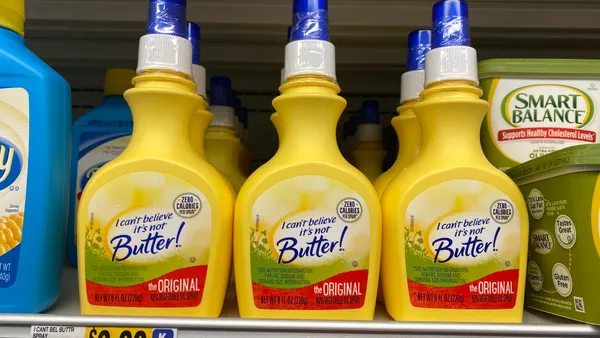Dive Brief:
- I Can’t Believe It’s Not Butter Spray’s labeling indicating a serving has zero calories or grams of fat is not misleading because it is classified as a spray, the U.S. 9th Circuit Court of Appeals ruled this week. The initial case was filed as a consumer class action issue 10 years ago in a California court.
- While the entire bottle of the pump-sprayed butter substitute is neither low in fat nor in calories — the initial complaint states the entire bottle has 771 calories and 82 grams of fat — the Nutrition Facts information that breaks down information based on a single spray is accurate, the court ruled. A spray of the flavoring is a distinct serving measurement that matches consumer use. Because of the use of the product, it doesn’t make sense to classify it as butter.
- The long-running lawsuit forced a close look at regulated definitions of different food items established by the FDA. The initial judge who considered the case also ruled the label was not misleading.
Key performance indicators every CFO should watch
Dive Insight:
FDA has a trove of legal classifications for different food items, and this case hinged on how to classify something that didn’t quite meet any of the pre-established definitions.
While I Can’t Believe It’s Not Butter Spray fits under the agency’s larger “Fats and Oils” category for regulatory purposes, the case looked at whether it should be considered under the “Butter, margarine, oil, shortening” segment, or the “Spray” segment. This matters because of the serving size for each. According to FDA, Nutrition Facts labeling should consider one tablespoon of the spreadable fats as a serving. For a spray — a category largely populated by oil products used by consumers to prevent food from sticking to cooking pans — the recommended serving size is 0.25 grams, or a number of seconds that the spray button is held down.
The label on the product indicates a serving of I Can’t Believe It’s Not Butter Spray is one spray, or 0.2 grams. At the time that the lawsuit was filed, the label also said a serving as a topping was five sprays. The initial lawsuit argued that these serving sizes are too low to reflect customary uses. Consumers may also be misled into thinking the actual product is low in fat and calories, which it is not.
The court’s ruling states it would take 40 sprays for a consumer to get a tablespoon of I Can’t Believe It’s Not Butter Spray — a use that is also not customary.
“Most any oil can fit in the ‘butter, margarine, oil, shortening’ category, but not every butter or oil-based product can be sprayed,” the ruling states. “Treating Butter! Spray as a butter/oil rather than a spray would threaten to undermine the specific categorization in the FDA’s regulatory scheme, potentially rendering the ‘spray type’ category meaningless.”
One of the judges on the appellate panel dissented, writing the idea that a bottle of oil laden with calories and fat could be transformed into something with zero calories or fat grams by replacing the bottle cap with a pump device is “ludicrous.”
In the years since this lawsuit was filed, there have been numerous changes, both in food labeling and I Can’t Believe It’s Not Butter. In 2016, Nutrition Facts labeling was revamped to provide information intended to better educate consumers. Many products have had the new labels for at least five years.
When the lawsuit was filed, I Can’t Believe It’s Not Butter was owned by Unilever. The company sold its spreads business to private equity firm KKR in 2018. The brand’s corporate parent is now known as Upfield.


